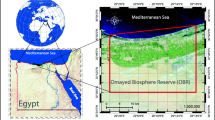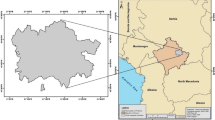Abstract
The results of the research at the Sudan Red Sea coast, which is part of the GTZ project “Integrated Biological Control of Grasshoppers and Locusts” will be presented. For detecting desert locust biotopes multitemporal Landsat Thematic Mapper data and ground truth information are analyzed. The Normalized Difference Vegetation Index (NDVI) shows the areas covered with vegetation. These areas are masked and then classified with the maximum likelihood classifier. Rectification and ground truthing are carried out by means of a GPS (Global Positioning System). The results of the multitemporal classification are merged with an enhanced satellite scene. The final map shows the potential desert locust biotopes. The current desert locust breeding area can be demarcated by combining the classification results with up-to-date data from monitoring satellites, such as Meteosat and NOAA. Further research is carried out in Mali and Mauritania.
Similar content being viewed by others
References
Barbour, K. M.: The Republic of the Sudan. A Regional Geography. London 1961.
Bryceson, K. P.: The use of Landsat MSS data to determine the distribution of locust eggbeds on the Riverina region of New South Wales, Australia. International Journal of Remote Sensing 10, 11, 1749–1762 (1989)
Deutsche Gesellschaft für Technische Zusammmenarbeit (GTZ) (ed.): GTZ-Project Integrated Biological Control of Grasshoppers and Locusts. Preliminary Research Findings. Eschborn (GTZ) 1991.
Dreiser, C.: Mapping and Monitoring of Migrant Pest Habitats with Remote Sensing Data: The Red — Billed Quelea in East Africa. Doctoral thesis in Print. Berliner Geographische Schriften (1993)
Dreiser, U.: Mapping of desert locust habitats in Sudan, Mali and Mauretania using Landsat Thematic Mapper data. Doctoral thesis in print. Berliner Geographische Schriften (1994)
Dreiser, U.: Mapping of desert locust habitats using remote sensing techniques. In: Genderen, J. L. van (ed.): Operationalization of remote sensing in developing countries. Proceedings of the International Symposium “Operationalization of Remote Sensing”, 19–23 April 1993, ITC Enschede, The Netherlands, Vol. 4, 1993.
Hielkema, J. U.; Roffey, J.; Tucker, C. J.: Assessment of ecological conditions associated with the 1980/81 desert locust plague upsurge in West Africa using environmental satellite data. International Journal of Remote Sensing 7, 11, 1609–1622 (1986)
Hielkema, J. U.; Ayyangar, R. S.; Sinha, P. P.: Satellite remote sensing, a new dimension in international desert locust survey and control. Plant Protection Bulletin (New Dehli) 33, 3–4, 165–173 (1981)
Krall, S.; Nasseh, O.: The Integrated Biological Control of Locusts and Grasshoppers — a GTZ research project. (Paper presented at the Workshop on Biological Control of Locusts and Grasshoppers, IITA, Cotonou/Republic of Benin, April 29–May 1st, 1991. Eschborn [GTZ]).
Mather, P. M.: Computer processing of remotely-sensed images. An introduction. Wiley, Chichester 1987.
McCulloch, C.; Hunter, D. M.: Identification and monitoring of Australian plague locust habitats from Landsat. Remote Sensing of Environment 13, 95–102 (1983)
Pedgley, D. (ed.): Desert locust forecasting manual. Centre of Overseas Pest Research, London 1981.
Popov, G. B.; Wood, T. G.; Haggis, M. J.: Insect Pests of the Sahara. In: Cloudsley-Thompson, J. L. (ed.): Key environments. Sahara Desert. Oxford 1984.
Steedman, A. (ed.): Locust handbook. Overseas Development Natural Resources Institute, London 1988.
Voss, F.; Dreiser, U.: Mapping of desert locust and other migratory pests habitats using remote sensing techniques. In: Deutsche Gesellschaft für Technische Zusammenarbeit (GTZ) (ed.): GTZ-Project Integrated Biological Control of Grasshoppers and Locusts. Research Findings. Eschborn (GTZ) 1993.
Author information
Authors and Affiliations
Rights and permissions
About this article
Cite this article
Dreiser, U. Mapping of desert locust habitats in Africa using Landsat Thematic Mapper data. GeoJournal 32, 55–60 (1994). https://doi.org/10.1007/BF00806357
Issue Date:
DOI: https://doi.org/10.1007/BF00806357




